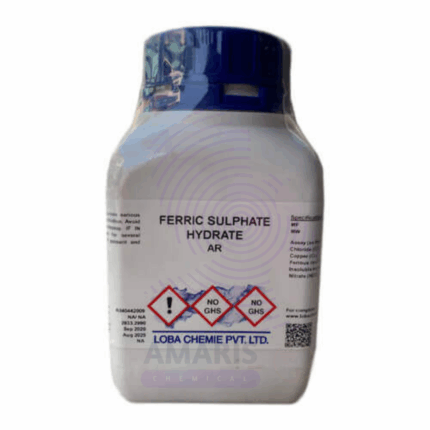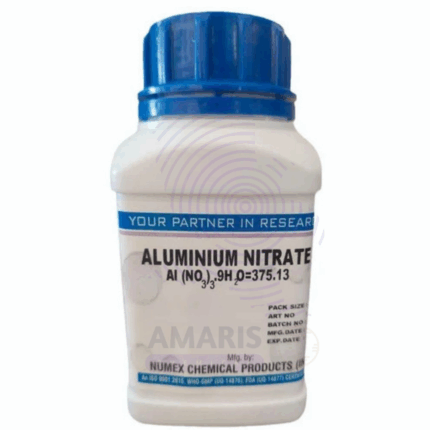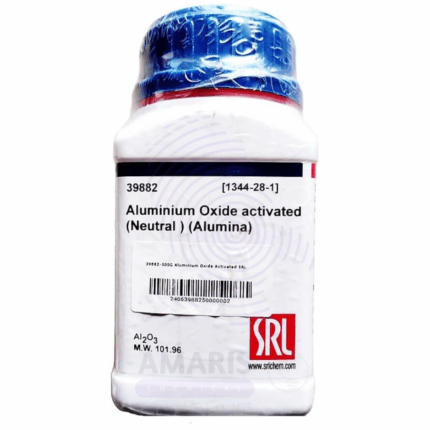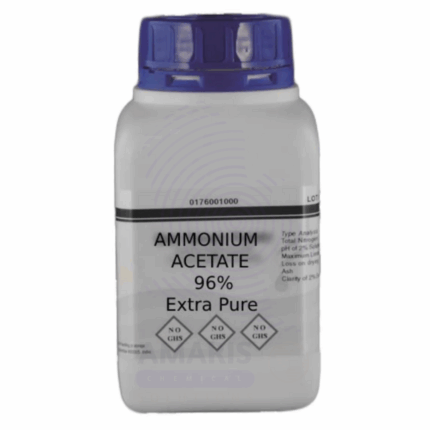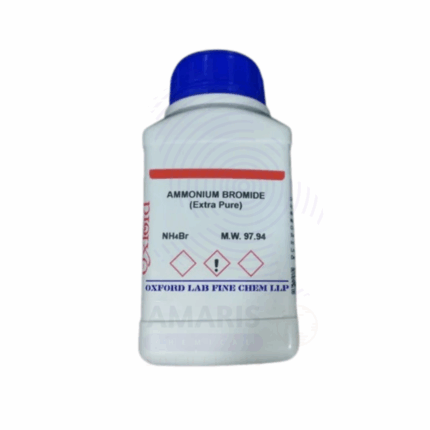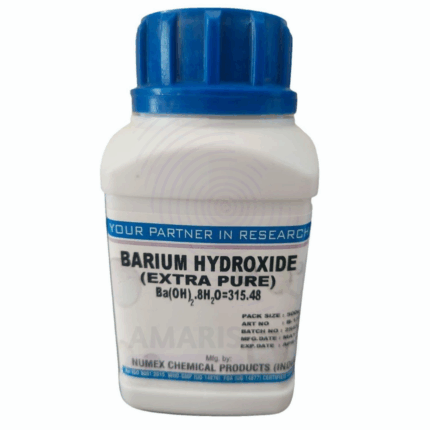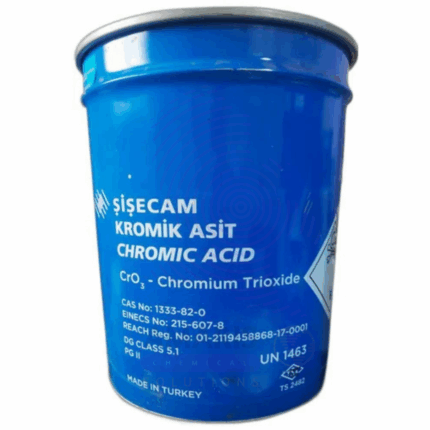

Potassium Dihydrogen Phosphate Extra Pure
$ 18.11 Original price was: $ 18.11.$ 17.98Current price is: $ 17.98.
Potassium Dihydrogen Phosphate Extra Pure, also known as monopotassium phosphate (MKP), is a white crystalline compound with excellent solubility in water and a slightly acidic pH. It serves as a valuable buffering agent and a source of both potassium and phosphorus in various chemical, agricultural, and food-grade applications. In laboratories, it is commonly used in the preparation of buffer solutions and nutrient media for microbial culture. In agriculture, it is employed as a high-efficiency fertilizer due to its dual nutrient content, promoting strong root development and flowering. This compound should be stored in a cool, dry place, away from incompatible substances and moisture to preserve its purity and effectiveness.
Potassium Dihydrogen Phosphate Extra Pure
PRIMARY USES
- Laboratory Reagent:
- Commonly used in buffer solutions to maintain stable pH in biochemical and analytical experiments.
- Key component in phosphate-buffered saline (PBS).
- Agricultural Fertilizer:
- Serves as a highly efficient source of phosphorus and potassium in specialty fertilizers.
- Promotes root development, flowering, and fruiting in crops.
- Food Additive:
- Used as an acidity regulator, nutrient, and buffer in food processing (E340).
- Found in baking powders, dry drink mixes, and dairy products.
- Pharmaceutical Use:
- Provides electrolyte replenishment in intravenous fluids and nutritional supplements.
SECONDARY USES
- Water Treatment:
- Helps in corrosion control and pH stabilization in water systems.
- Animal Feed Additive:
- Provides essential phosphorus and potassium in formulated animal diets.
- Electronics and Industrial Applications:
- Used in ceramics, optical glass, and crystal growth for semiconductors.
1. Basic Identification Attributes
- Chemical Name: Potassium Dihydrogen Phosphate
- CAS Number: 7778-77-0
- HS Code: 2835.24.00
- Molecular Formula: KH₂PO₄
- Synonyms:
- Monopotassium phosphate (MKP)
- Potassium phosphate monobasic
- Monobasic potassium phosphate
- Primary potassium phosphate
2. Physical & Chemical Properties
- Physical State: Solid (crystalline powder or granules)
- Color & Odor: White, odorless
- Boiling Point & Melting Point:
- Melting Point: 252 °C (decomposes)
- Boiling Point: Not applicable (decomposes before boiling)
- Density/Specific Gravity: ~2.34 g/cm³
- Solubility:
- Soluble in water (22.6 g/100 mL at 25 °C)
- Insoluble in ethanol
- pH Level: ~4.4 to 4.7 (1% solution)
- Vapor Pressure & Volatility: Non-volatile
- Flash Point: Not flammable
- Autoignition Temperature: Not applicable
- Viscosity: Not applicable (solid)
3. Safety & Hazard Attributes
- Hazard Class (GHS Classification):
- Not classified as hazardous under GHS
- NFPA Ratings:
- Health: 1
- Flammability: 0
- Reactivity: 0
- Exposure Limits:
- No OSHA PEL or ACGIH TLV specified; considered low hazard
- Reactivity:
- Stable under normal conditions
- Avoid strong oxidizers and strong bases
4. Storage & Handling Attributes
- Storage Conditions:
- Store in cool, dry, well-ventilated area
- Keep container tightly sealed
- Incompatible Materials:
- Strong oxidizing agents
- Container Type:
- Plastic, glass, or lined metal containers
- Shelf Life & Expiration Date:
- Stable for at least 3 years if properly stored
- Special Handling Requirements:
- Use gloves and eye protection during handling
- Avoid inhaling dust
5. Regulatory & Compliance Attributes
- Regulatory Status:
- Listed on TSCA inventory
- Approved for use in food and fertilizer applications
- Complies with FCC and USP specifications
- Hazard Symbols (GHS Pictograms):
- None required
- Transportation Restrictions:
- Not regulated for transport
- Waste Disposal Method:
- Dispose in accordance with local and national regulations
- Generally considered non-hazardous waste
6. Environmental & Health Impact
- Ecotoxicity:
- Low toxicity to aquatic organisms
- Persistence in Environment:
- Readily dissociates and contributes to nutrient load (may lead to eutrophication in large quantities)
- Carcinogenicity/Mutagenicity:
- Not classified as carcinogenic or mutagenic
- Biodegradability:
- Inorganic salt; not biodegradable but environmentally acceptable in small amounts
- Inorganic salt; not biodegradable but environmentally acceptable in small amounts
SAFETY PRECAUTIONS
Personal Protective Equipment (PPE):
- Wear protective gloves (e.g., nitrile).
- Use safety goggles or face shields.
- Wear a lab coat or suitable protective clothing.
- Ensure adequate ventilation when handling powders.
Handling:
- Avoid breathing dust.
- Do not eat, drink, or smoke while handling.
- Handle with care to avoid spillage and dust formation.
Storage:
- Store in a tightly closed container.
- Keep in a cool, dry, and well-ventilated area.
- Keep away from incompatible materials (e.g., strong oxidizers).
FIRST AID MEASURES
Inhalation:
- Move the person to fresh air immediately.
- Seek medical attention if symptoms persist.
Skin Contact:
- Wash skin thoroughly with soap and water.
- Remove contaminated clothing and launder before reuse.
- Get medical attention if irritation develops.
Eye Contact:
- Rinse immediately with plenty of water for at least 15 minutes.
- Seek medical help if discomfort or redness continues.
Ingestion:
- Rinse mouth with water.
- Do not induce vomiting.
- Seek medical attention, especially if a large amount is consumed.
FIRE FIGHTING MEASURES
Flammability:
- Not flammable.
Extinguishing Media:
- Use appropriate media for surrounding fire: water spray, dry chemical, foam, or CO₂.
Hazardous Combustion Products:
- May release phosphorus oxides and potassium compounds on thermal decomposition.
Firefighter Protection:
- Wear self-contained breathing apparatus (SCBA) and full protective gear.
- Avoid breathing combustion fumes.


 Preservatives(food)
Preservatives(food) Flavor Enhancers
Flavor Enhancers Acidulants
Acidulants Sweeteners
Sweeteners Antioxidants
Antioxidants Colorants(food)
Colorants(food) Nutraceutical Ingredients (food)
Nutraceutical Ingredients (food) Nutrient Supplements
Nutrient Supplements Emulsifiers
Emulsifiers
 Collectors
Collectors Dust Suppressants
Dust Suppressants Explosives and Blasting Agents
Explosives and Blasting Agents Flocculants and Coagulants
Flocculants and Coagulants Frothers
Frothers Leaching Agents
Leaching Agents pH Modifiers
pH Modifiers Precious Metal Extraction Agents
Precious Metal Extraction Agents
 Antioxidants(plastic)
Antioxidants(plastic) Colorants (Pigments, Dyes)
Colorants (Pigments, Dyes) Fillers and Reinforcements
Fillers and Reinforcements Flame Retardants
Flame Retardants Monomers
Monomers Plasticizers
Plasticizers Polymerization Initiators
Polymerization Initiators Stabilizers (UV, Heat)
Stabilizers (UV, Heat)
 Antifoaming Agents
Antifoaming Agents Chelating Agents
Chelating Agents Coagulants and Flocculants
Coagulants and Flocculants Corrosion Inhibitors
Corrosion Inhibitors Disinfectants and Biocides
Disinfectants and Biocides Oxidizing Agents
Oxidizing Agents pH Adjusters
pH Adjusters Scale Inhibitors( water)
Scale Inhibitors( water)
 Antioxidants(cosmetic)
Antioxidants(cosmetic) Emollients
Emollients Fragrances and Essential Oils
Fragrances and Essential Oils Humectants
Humectants Preservatives
Preservatives Surfactants(cosmetic)
Surfactants(cosmetic) Thickeners
Thickeners UV Filters
UV Filters
 Fertilizers
Fertilizers Soil Conditioners
Soil Conditioners Plant Growth Regulators
Plant Growth Regulators Animal Feed Additives
Animal Feed Additives Biostimulants
Biostimulants Pesticides (Herbicides, Insecticides, Fungicides)
Pesticides (Herbicides, Insecticides, Fungicides)
 Active Pharmaceutical Ingredients (APIs)
Active Pharmaceutical Ingredients (APIs) Excipients
Excipients Solvents(pharmaceutical)
Solvents(pharmaceutical) Antibiotics
Antibiotics Antiseptics and Disinfectants
Antiseptics and Disinfectants Vaccine Adjuvants
Vaccine Adjuvants Nutraceutical Ingredients (pharmaceutical)
Nutraceutical Ingredients (pharmaceutical) Analgesics & Antipyretics
Analgesics & Antipyretics
 Analytical Reagents
Analytical Reagents Solvents(lab)
Solvents(lab) Chromatography Chemicals
Chromatography Chemicals Spectroscopy Reagents
Spectroscopy Reagents microbiology-and-cell-culture-reagents
microbiology-and-cell-culture-reagents Molecular Biology Reagents
Molecular Biology Reagents Biochemical Reagents
Biochemical Reagents Inorganic and Organic Standards
Inorganic and Organic Standards Laboratory Safety Chemicals
Laboratory Safety Chemicals Specialty Laboratory Chemicals(Special Laboratory Equipment)
Specialty Laboratory Chemicals(Special Laboratory Equipment)
 Demulsifiers
Demulsifiers Hydraulic Fracturing Fluids
Hydraulic Fracturing Fluids Scale Inhibitors(oil)
Scale Inhibitors(oil) Surfactants(oil)
Surfactants(oil) Drilling Fluids
Drilling Fluids
 Dyes and Pigments
Dyes and Pigments Bleaching Agents
Bleaching Agents Softening Agents
Softening Agents Finishing Agents
Finishing Agents Antistatic Agents
Antistatic Agents
 Admixtures
Admixtures Waterproofing Agents
Waterproofing Agents Sealants and Adhesives
Sealants and Adhesives Curing Compounds
Curing Compounds Concrete Repair Chemicals
Concrete Repair Chemicals Anti-Corrosion Coatings
Anti-Corrosion Coatings
 Surfactants(cleaning)
Surfactants(cleaning) Builders
Builders Enzymes
Enzymes Solvents (Cleaning)
Solvents (Cleaning) Fragrances
Fragrances
 Electronic Chemicals
Electronic Chemicals Catalysts
Catalysts Lubricants
Lubricants Photographic Chemicals
Photographic Chemicals Refrigerants
Refrigerants Automotive chemicals
Automotive chemicals Pyrotechnic Chemicals
Pyrotechnic Chemicals
 Biodegradable Surfactants
Biodegradable Surfactants Bio-based Solvents
Bio-based Solvents Renewable Polymers
Renewable Polymers Carbon Capture Chemicals
Carbon Capture Chemicals Wastewater Treatment Chemicals
Wastewater Treatment Chemicals
 Pigments
Pigments Solvents(paint)
Solvents(paint) Specialty Coatings
Specialty Coatings Binders/Resins
Binders/Resins Additives
Additives Driers
Driers Anti-Corrosion Agents
Anti-Corrosion Agents Functional Coatings
Functional Coatings Application-Specific Coatings
Application-Specific Coatings
 Fresh Herbs
Fresh Herbs Ground Spices
Ground Spices Whole Spices
Whole Spices Spice Blends
Spice Blends Dried Herbs
Dried Herbs
 Leavening Agents
Leavening Agents Dough Conditioners
Dough Conditioners Flour Treatments
Flour Treatments Fat Replacers
Fat Replacers Decoratives
Decoratives Preservatives(baking)
Preservatives(baking)
 Plasticizers & Softeners
Plasticizers & Softeners Reinforcing Agents
Reinforcing Agents Adhesion Promoters
Adhesion Promoters Vulcanizing Agents
Vulcanizing Agents Antidegradants
Antidegradants Blowing Agents
Blowing Agents Fillers & Extenders
Fillers & Extenders Accelerators & Retarders
Accelerators & Retarders

